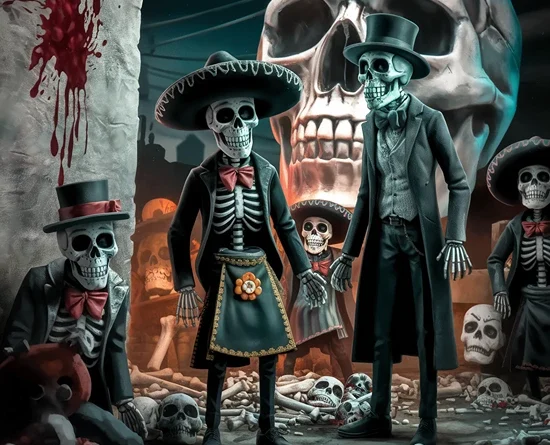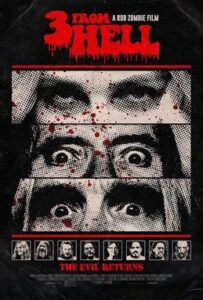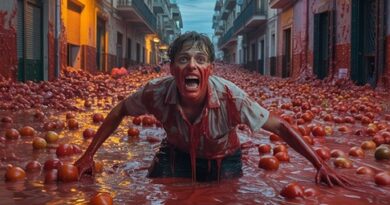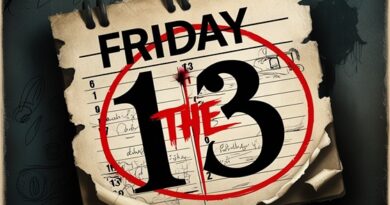Mexican Day Of The Dead Is A Holiday Worth Living For
No matter how you look at death, it’s hard to see it as a happy event. Still, some cultures try to prove that it’s possible to celebrate even in these circumstances, mainly to honor, remember, and cherish those who have passed away. The most obvious example is the Day of the Dead in Mexico (in Spanish: “Dia de los Muertos”), also celebrated in other countries, mainly in the Americas.
With creepy costumes and traditions that may seem strange to an outsider, it’s no surprise that it’s also one of the scariest holidays on the world calendar today – which explains why you, horror fans, should learn about its reasons, habits, and primary influences.
What Is The Day Of The Dead?
Day of the Dead is a Mexican holiday, part of the Catholic celebrations held in memory of deceased family ancestors.
Contrary to our initial instinct about death, the holiday is supposed to be a joyful and lively celebration of memory, tradition, and nostalgia, somewhat reminiscent of Halloween in the United States.
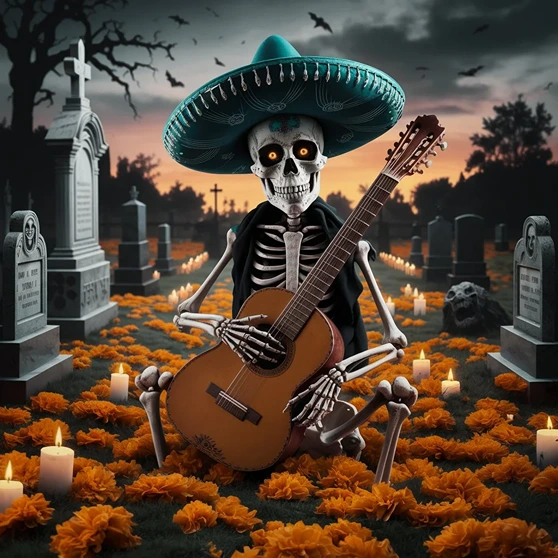
When Is The Day Of The Dead?
The holiday is celebrated yearly on the 1 and 2 of November to honor loved ones who passed away. Still, some localities include other dates in the celebration, like October 31 and November 6.
Where Is The Day Of The Dead Celebrated?
It is important to note that the holiday is not only celebrated in Mexico but also in various Central American countries. It is celebrated mainly in countries with Mexican minorities, some South American countries, the Caribbean islands, and more.
The Day Of The Dead History And Origin
The roots of the Day of the Dead are deeply rooted in Mexico’s pre-Columbian history. The ancient cultures in the country, such as the Aztec culture or the Mayans, held ceremonies in honor of the dead for thousands of years. The Aztecs, for example, celebrated a festival dedicated to the goddess of the dead, Mictēcacihuātl, which also included ceremonies in memory of the deceased. The Aztecs saw the holiday as part of the cycles of nature and, therefore, chose to celebrate it at the beginning of August, the traditional time of the corn harvest.
In the 15th century, Mexico was conquered by the Spanish conquistadors, and various religions arrived in the country. At this point, it was necessary to combine the traditional customs of the natives with those that came with the conquerors, especially concerning Christianity and the Catholic movement. At this point, it was decided to unite the celebrations of the dead with other essential holidays celebrated in Catholic Christianity on these dates: All Saints’ Day (November 1), dedicated to Christians who died due to their religion and art, and All Souls’ Day (November 2), which includes rituals, prayers and feasts to commemorate the dead.
In 2008, UNESCO recognized the Day of the Dead as part of the Intangible Cultural Heritage of Humanity (ICH), further increasing the importance of the holiday and making it more widely known in countries outside the Americas. Several critical cultural texts contributed to this, but we will get to that later.
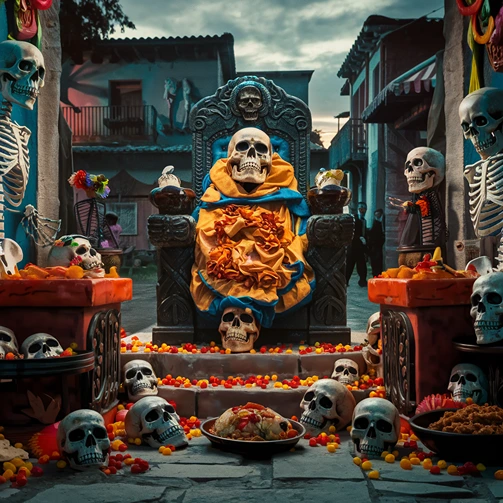
Home Altars, Breads And Sweets: The Main Habits Of The Mexican Day Of The Dead
The Day of the Dead has various customs and traditions, some of which vary from region to region in Mexico and other countries that celebrate the holiday. A central principle is that the holiday combines elements from the local tradition of the specific country or region alongside modern or even more universal symbols.
On Mexican Day of the Dead, families go to cemeteries and churches equipped with flowers, candles, favorite foods, or personal belongings of the deceased. Some families set up home altars (known as “ofrendas”) at burial sites or in their homes, cleaning the graves and spending a certain amount of time near them, from a few hours to a whole night.
The list of specific offerings for the deceased can include flowers -Especially marigolds, known in Spanish as the “Flowers of Death.” The locals believe that marigolds summon the ghosts of the dead thanks to their strong scent and bright orange hue. Other offerings are tequila bottles, sweets, and toys (for children). One of the beliefs that explains these choices is that the smells of the food and flowers may attract the souls of the dead back to the world of the living.
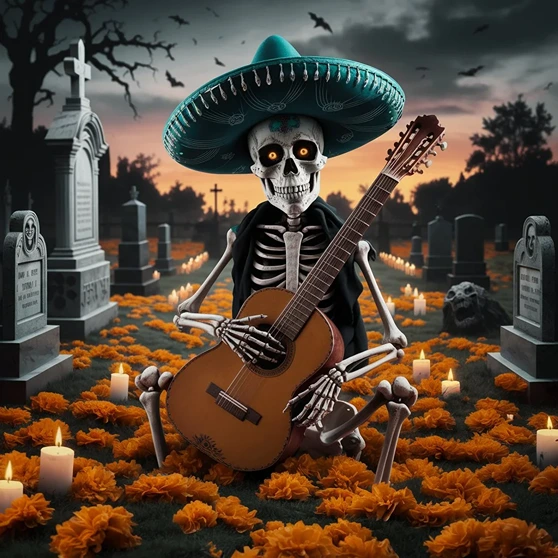
Day of the Dead celebrations combine several traditional dishes. “Bread of the Dead” (Pan de Muerto) is a sweet local pastry that looks like a bun with a twist: it is baked in a way that resembles “rolls,” which, according to biological jargon, are the bones that make up the skeletons of the fingers and toes. The bread is baked in honor of the holiday to commemorate the dead, placed on altars, and eaten as an integral part of the celebrations.
Children indeed die (metaphorically) for the Calaveras – colorful skull-shaped sweets and candies, sometimes with the names of the dead on their backs. They are distributed and eaten by adults and young people alike, despite (and perhaps because) the emphasis on their appearance and less on the taste or the choice of quality ingredients.
The holiday also includes quite a few drinks, mainly alcoholic ones. In the past, it was very common to bring in the traditional Mexican alcoholic drink Pulque. Today, many families choose to “go with it” with whatever their dead would have liked to drink.
Day Of The Dead Costumes: When the Holiday Becomes A Visual Celebration
With all due respect to the traditions surrounding the Day of the Dead in Mexico, vital as they may be, there is no doubt that from an objective point of view, one of the highlights is that the holiday is spectacular in its beauty.
It starts with the traditional decorations used, such as colorful and delicately carved paper (Papel Picado), which symbolizes, among other things, the fragile side of life. Year after year, we get different “Western” elements, also inspired by Hollywood, and the result is more than just a “Mexican version of Halloween.”
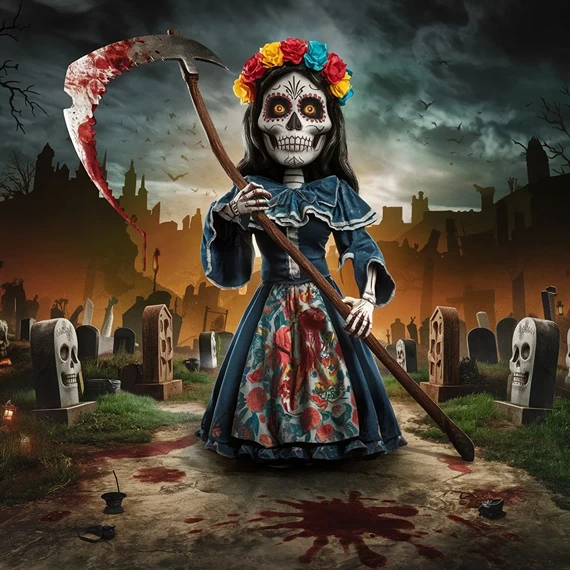
La Calavera Catrina
Many cities hold colorful parades and festivals during the holiday, which include traditional costumes. One of the most important of these is the costume of the “The Dapper [female] Skull,” known as “La Calavera Catrina.” This character was first created as a zinc etching by the Mexican printmaker and lithographer José Guadalupe Posada in the early 20th century as part of a critique of women in the upper social class – as can be deduced from the fact that the skeletal woman is elegant in her attire, which includes, among other things, a Victorian dress and a fancy hat.
In 1946-1947, Mexican muralist Diego Rivera upgraded Posada’s initial work, transforming it into a full-scale figure he placed in his fresco (today, you can see it in the museum named after him). Rivera somewhat reduced the visual significance of the figure, which had become a national symbol of Mexico.
The Dapper [female] Skull is mainly associated with the Day of the Dead and has become a symbol of Mexican identity for many. Alongside this famous character, you can find a variety of other Day of the Dead costumes, such as “regular” skeletons, with a twist in some cases (such as colorful clothing or colorful attire). The list of costumes may also include local mythological figures, historical figures, and Mexican celebrities, such as the famous artist Frida Kahlo.
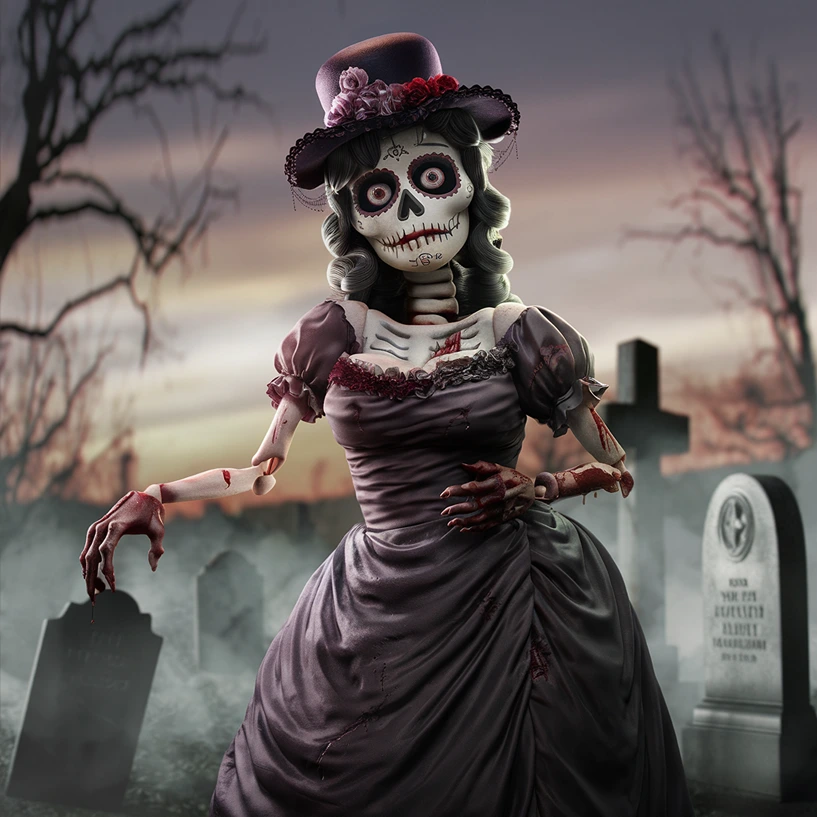
Mexican Day Of The Dead Makeup: A Central Part Of The Experience
We cannot ignore the Day of the Dead makeup styles and techniques, which sometimes integrate with the costume or in its place. You can find a wide variety of guides online, written or filmed, that will explain exactly how to create makeup that corresponds to the visual aspect of the Day of the Dead.
The main goal of Day of the Dead makeup is to reflect the idea that death is a natural part of life in a somewhat ironic way and to emphasize the beauty and colorfulness of the holiday. You can see this in elements such as:
💀 Skull makeup: face painting of a white skull, with black elements, mainly around the eyes and mouth
💀 Flowers and various decorations, which may be colorful
💀 Stitches, mainly in the lip area
💀 Shades: use of strong and bright shades, such as red, orange, and purple, to decorate the face (alongside black and white, of course)
💀 Bright elements, such as small gems or “glitter”
Mexican Day Of The Dead In Western Culture
Mexican Day of the Dead has become a popular theme in global popular culture, especially cinema. We can find references in various genres: sometimes at the level of a single scene and sometimes at an even more pronounced level, such as an entire animated film that focuses on the tradition of the Day of the Dead and builds an exciting story around it. Unfortunately, most of the cultural texts we will refer to here are not from the world of horror, but one can always hope for changes.
Animated films are cinema’s most significant representation of the Day of the Dead. You can understand why: it is a colorful holiday that looks great on the screen and includes customs that speak (also) to the world of children.
Here are some notable Day of the Dead animated movies:
Coco (2017)
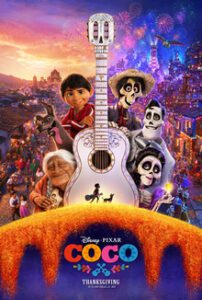
Pixar’s excellent animated film “Coco” is probably mainstream cinema’s most famous and widespread representation of the Day of the Dead. The film won the Oscar for Best Animated Film and Best Original Song, as well as the Golden Globe.
“Coco” follows Miguel, a Mexican boy who accidentally enters the world of the dead on the day of the holiday. Miguel dreams of becoming a musician, but his family is against making his dream come true. When Miguel discovers that his grandmother has broken his guitar, he breaks into the mausoleum of his favorite musician (and, in his belief, one of the family patriarchs), “borrows” the guitar and enters the Island of the Dead. According to local tradition, this happens because one can’t steal from a dead person on the Day of the Dead. Miguel realizes that if he does not receive the longed-for blessing from one of his family members, he will remain stuck in the world of the dead forever. The result is moving, perhaps even too complex for children and teenagers.
“Coco” presents in great detail the customs and traditions of the holiday while emphasizing the importance of memory and family in Mexican culture. It also teaches us something about the fulfillment of dreams and personal will.
Corpse Bride (2005)
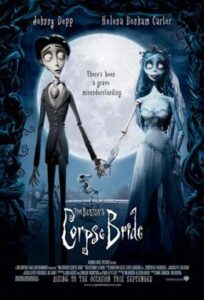
Although Tim Burton’s masterful animated film “Corpse Bride” is not directly about the Day of the Dead, it is largely based on the aesthetics and ideas of the holiday. The film presents a colorful and lively world of the dead, similar to the Mexican concept. The colorful and musical skeleton characters are reminiscent of Mexican culture’s festive approach to death.
Not surprisingly, the film includes skeletons and other characters that fit well with the visuals of the Mexican Day of the Dead—for example, a reference to the famous Skeleton Dance.
The Book Of Life (2014)
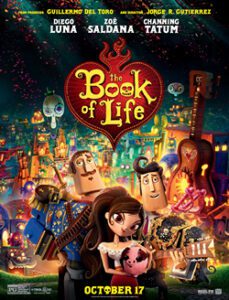
“The Book of Life” is a Fox animated film that focuses directly on the Day of the Dead and its mythology in the form of a fairy tale a teacher tells her students on a bus on an annual trip. The film presents a magical fairy tale, the central plot of which is a bullfighter who goes on an adventure after his death, partly to fulfill the expectations of his family and loved ones on the Day of the Dead.
“The Book of Life” highlights the holiday’s unique aesthetic, emphasizing intricate designs and rich details based on Mexican tradition.
From James Bond To The Crow: Action And Crime Films
If Mexico reminds you of a crime film, you may be overgeneralizing. Still, it is undoubtedly one of the most dangerous countries in the world, as evidenced by the data showing that it has the fourth highest crime rate in the country.
A few films have taken it a few steps further, with notable scenes set around the Day of the Dead. The opening scene in “Spectre,” the 24th James Bond film, takes place during the Day of the Dead, at a festive procession in Mexico City. In the bombastic scene, our lovely Bond (Daniel Craig), wearing the traditional skeleton mask, uses a girl to track an Italian criminal. The scene includes some great shots, most notably a tracking shot that shows all the fun going on in the city. By the way, Mexico City didn’t have a significant parade like this before the film, but due to the demand the film generated, it is said that since then, they have been careful to hold exhibitions of this type.
Some of the plots of various crime films, even successful ones, occur around the Day of the Dead in Mexico. “Blood In Blood Out” (1993) follows three brothers in a Mexican family – a tormented and drugged artist, a criminal, and a police officer – and includes a scene of a violent coup in a prison on the Day of the Dead.
Robert Rodriguez’s tedious “Once Upon a Time in Mexico” (2006), starring Antonio Banderas, Salma Hayek, and Johnny Depp, also includes a coup in its storyline around the Day of the Dead.
“The Crow: City of Angels” (1996), the sequel to “The Crow,” was produced in the shadow of the trauma of the death of actor Brandon Lee on the set of the first film. The plot here is set in Los Angeles, as you might have guessed from the title, but it deals with the celebrations surrounding the Day of the Dead. The plot of “The Crow: City of Angels” centers on a father and son who witness the murder of members of a drug gang but are themselves murdered as a result. The father returns from the dead to take revenge, as the Crow, of course.
The popularity of these films has led to increased interest in the customs and aesthetics of the holiday outside of Mexico. A clear proof is the rise in the popularity of Day of the Dead-style costumes and makeup at Halloween celebrations worldwide and the incorporation of holiday elements into art and design. The problem is that these changes can also simplify or “over-romanticize” a deep and complex tradition. Therefore, it is vital to understand the entire cultural and historical context of the Day of the Dead beyond its cinematic representations.
Day Of The Dead Horror Movies
As is our tradition, it’s time to examine how horror cinema has addressed the myth surrounding the Day of the Dead. The disappointing news is that we haven’t found many significant references in horror cinema as of this writing.
George Romero’s excellent 1985 zombie film “Day of the Dead,” the third in the zombie film series (after “Night of the Living Dead” (1968) and “Dawn of the Dead” (1978)), is named after the holiday but does not refer to it. Some say they looked for all sorts of terms they could combine with the phrase “Of the Dead” and chose “Day of the Dead.”
So, which Day Of The Dead horror movies are still out there?
3 From Hell (2019)
Rob Zombie’s crazy film “3 From Hell,” the third in the Firefly trilogy (after “House of 1,000 Corpses” and “The Devil’s Rejects”), begins with the news that the members of the crazy family survived the shootout with the police. They arrive at the prison, two of them escape, and eventually, the third one. They flee, cross the border, and come to a small Mexican town during the Day of the Dead celebrations. The guys fit in well with the celebration, including local escort girls. The problem is that there is someone there who recognizes them and tries to delay them so that someone who wants to kill them can come and kill them.
Here is one of the main scenes of “3 From Hell,” which takes place on the Day of the Dead:
Potent Media’s Sugar Skull Girls (2016)
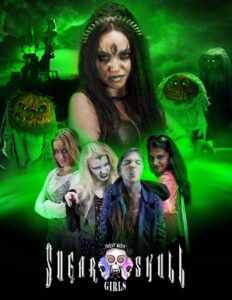
A few relatively insignificant horror films relate closely to the Day of the Dead. “Potent Media’s Sugar Skull Girls” from 2016 is a relatively unknown film with a low budget and poor quality, as you can deduce from its sloppy poster and trailer, from the fact that you probably haven’t heard of it and from its rating on IMDB: a little more than 2.5 out of 10, after a little more than 150 ratings made over almost a decade.
The plot of “Potent Media’s Sugar Skull Girls,” if I got it right (I am not one of the 150 lucky horror fans to rate this film,) focuses on a failed attempt to resurrect a little girl from the dead. The failed attempt causes three demonic sisters to arrive from the “other side” and do all sorts of low-budget things.
All Souls Day: Dia De Los Muertos (2005)
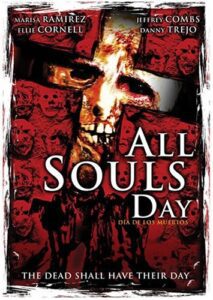
The 2005 Mexican horror film “All Souls Day: Dia de los Muertos” is (slightly) better known to the general public, but its quality also seems problematic. The film centers on a zombie attack on the Day of the Dead. A young couple who arrive in a small town in the country encounter a human sacrifice ceremony, part of the local tradition that is supposed to please the ancient gods. From here to the mass exodus of the dead from their graves, the road seems short.
💀 Killer Deals & Scary Recommendations 💀
🎭 Costumes & Accessories
HalloweenCostumes Fun Costumes Entertainment Earth
🛒 Online Shopping
AliExpress Amazon Walmart Etsy
🧛 Collectibles & Horror Brands
Funko Hot Topic Lego Spirit Halloween
🎢 Attractions & Tours
GetYourGuide Tiqets Viator Klook
📖 Blogs & Horror Sites
Bloody Disgusting iHorror Fangoria
🩸 Disclaimer: Some links are affiliate links. The price stays the same – it just helps keep the site alive 👻

